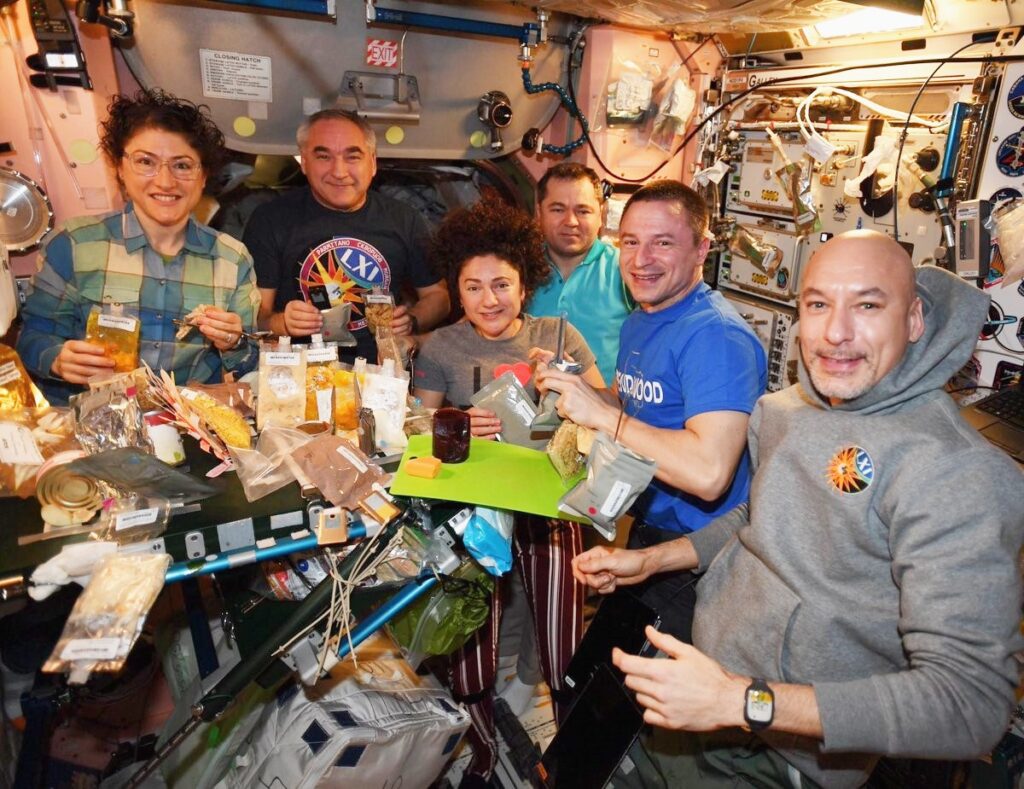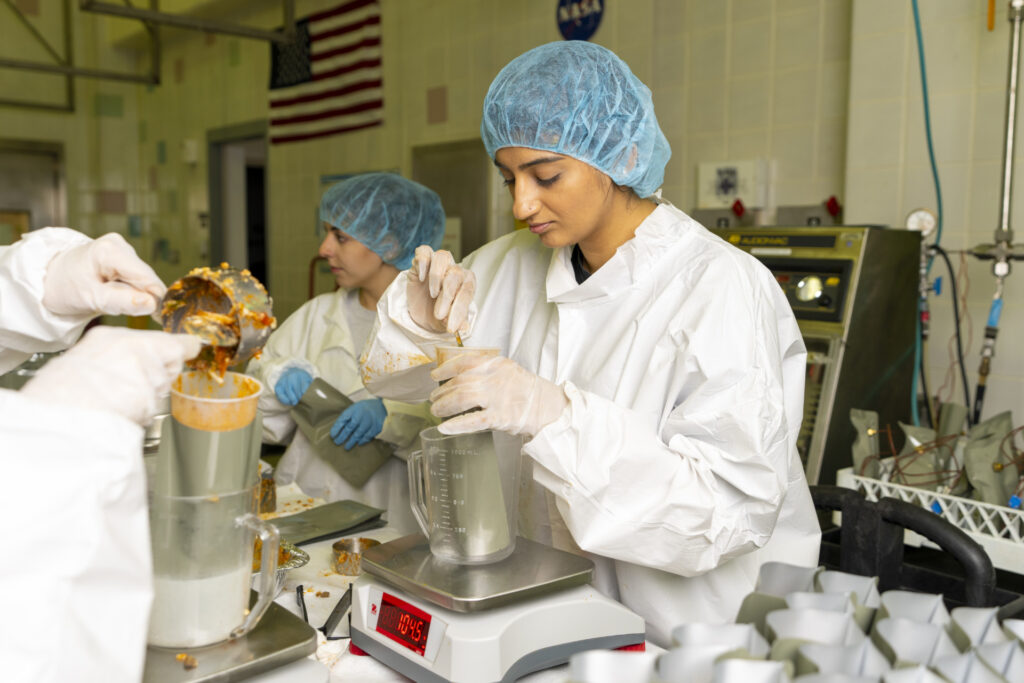What’s for ‘launch’? Space food reaching new heights
NASA and Texas A&M collaboration light years beyond ‘cubes and tubes’ of yesterday
The space program has come a long way since the days of the Gemini and Mercury missions, and so has the food the astronauts consume during their space missions.

Today, there is a far greater variety of food than the original “cube and tube” foods astronauts ate during those early NASA missions. Now they have a wide array of interesting and tasty items on their menu, including seafood gumbo, beef fajita strips, lasagna, honey ginger fish and pickled beets, as well as chocolate pudding cake and apricot cobbler.
Since 2007, the Texas A&M Food Technology Facility for Electron Beam and Space Food Research has been partnering with NASA’s Johnson Space Center and its contractors to develop, produce, thermostabilize and package foods for astronauts on space missions.
“About 30% of the food items the astronauts consume in space are made at our facility,” said Suresh Pillai, Ph.D., associate head of the Department of Food Science and Technology in the Texas A&M College of Agriculture and Life Sciences, who serves as principal investigator of the project and the facility director. “That means 50-60 of the food menu items in thermostabilized pouches that wind up on space come from here.”
Pillai said collaborating with the Johnson Space Center to produce space foods keeps with the department’s mission to be the premier program in the world by providing unique, high-impact education and research programs that apply contemporary and novel technologies in food processing, safety, quality and sustainability.
The Space Food Research Facility at Texas A&M
Recipes are custom-designed by food scientists at the Johnson Space Center in Houston and are prepared at the Space Food Research Facility on the Texas A&M campus. The Space Food Research Facility collaborates with NASA’s Space Food Systems Laboratory, which produces freeze-dried food and packages commercially available beverage powders, cookies, candy and other items for the astronauts.

Pillai said because the Texas A&M facility is only about 120 miles from the Johnson Space Center, it provides an attractive location for collaborating on space food production.
The Texas A&M facility is equipped with a variety of unit processes for preparing the foods and for long-term food preservation in support of NASA’s activities, Pillai said.
“The equipment at our facility can be used for thermostabilizing the foods, modified atmosphere packaging of foods, and vacuum-sealing, freeze-drying and canning of foods,” he said.
Pillai said the Space Food Research Facility is unique in that it provides both government industry and academic scientists the opportunity to investigate the combination of a variety of food processing technologies in addition to legacy thermostabilization of foods.
“In recent years, graduate students in the department have investigated the combination of electron beam, or eBeam, processing with freeze-drying for fruits,” he said. “They have also investigated the combination of eBeam and modified atmosphere pressure for fresh vegetables, as well as the use of eBeam technology to preserve cooked foods, such as beef fajitas and prepared meals. These cutting-edge projects are aimed at the rapidly expanding commercial space industry.”
Developing flavorful and healthy space foods
Food scientists strive to provide a diverse variety of meals and food options for the astronauts.

“Astronauts make many sacrifices in their commitment to travel in space, so we feel they should have foods that are fun and flavorful while they are up there,” said John Vollmer, a food scientist and employee of Leidos, a NASA subcontractor.
Vollmer, who works from the Space Food Research Facility, said the mass of the food has impacts on the overall weight and payload of the flight. He said that makes it even more important that the astronauts enjoy their meals and eat everything they provide for them on their missions.
According to the Space Food Systems Laboratory, the astronauts who have been selected for the new Artemis II mission — the first crewed mission on NASA’s path to establishing a long-term presence on the moon for science and exploration — will have similar food choices as crew members on the International Space Station.
Preparing food for space
Meals at Texas A&M’s Space Food Research Facility are prepared where food scientists representing NASA and the university work together. The meals are made in a manner similar to Meals-Ready-to-Eat, MREs, used by the military, but are specially developed to meet the nutritional needs of astronauts in space.

Many of the ingredients for the foods prepared at the facility are purchased fresh from grocery stores in the Bryan-College Station area. Ingredients are weighed and their use in each recipe is verified. The prepared food is then placed in commercial pouches and the top is sealed.
“The food processing techniques and packaging solutions vary based on the item’s perishability, ingredient composition and the amount of the item we have on inventory,” Vollmer said. “The food needs to be nutritionally balanced and, most of all, safe to eat.
He added that because the items are stored without refrigeration, they have to be prepared, treated and packaged to last for months or even years.
Filled pouches are put through a water spray retort that operates at 252 degrees and 35 psi. The retort renders the pouches “commercially sterile” and provides a stress test of sorts for pouch integrity. Quality control processes include verifying the item’s weight, ensuring product consistency, removing any residual air and placing the pouches in a vacuum chamber to do a final check for leaks.
Out-of-this-world experience for Texas A&M students
Scientists at the Space Food Research Facility employ Texas A&M students who have selected food science or nutrition as a major.
Sara Parsons, who is now dosimetrist and quality assurance manager at the National Center for Electron Beam Research, which is located in the same building, was previously a student worker at the Space Food Research Facility.
“It was a very cool experience to play my small part in space exploration,” Parsons said.
She said the facility gives the employed students real experience working in a food lab, ultimately preparing them for a future career in food science.
“The food processing requirements are developed by NASA and must be followed precisely to ensure safety and good health for those eating in space,” she said. “It’s important the student workers have the opportunity to work in a highly controlled setting where quality assurance is taught, followed and taken very seriously.”


